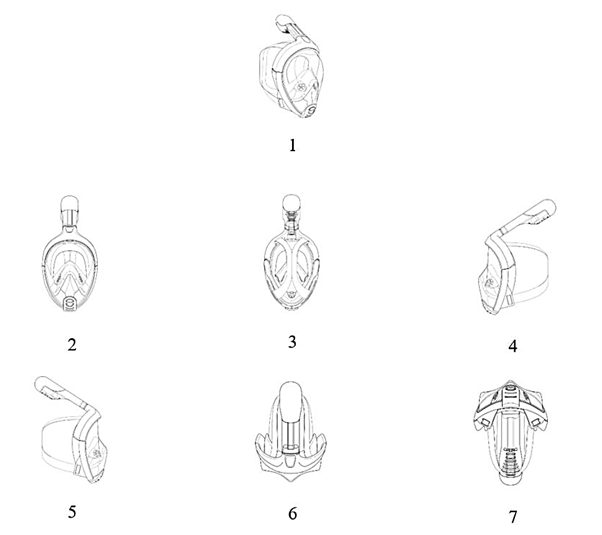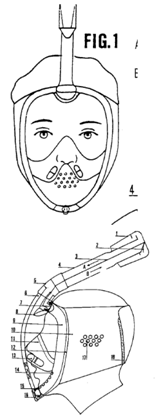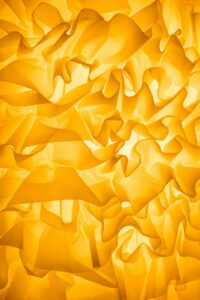29/07/2025
When it comes to design protection in the EUIPO, there is often a fine line between functionality and creativity. The recent General Court decision in Sport Handelskontor GmbH v EUIPO and Decathlon (Case T-1061/23) dives into that line.
At the centre of this dispute was Decathlon’s Easybreath diving mask. Its sleek design allows users to breathe through both nose and mouth while enjoying a wide field of vision. But the question was whether the mask’s visual features were too technical to qualify for protection under EU design law?
Background to the Dispute
On 30 March 2021, Delta-Sport Handelskontor GmbH (“Delta-Sport”) filed an application for a declaration of invalidity of registered EU design number 2526699-0001, owned by Decathlon.

Delta-Sport alleged that all the design elements were dictated exclusively by the mask’s technical function.
On 19 July 2022, the Invalidity Division rejected the application for a declaration of invalidity.
On 7 September 2022, Delta-Sport filed a notice of appeal with the EUIPO against the decision of the Invalidity Division. The appeal was dismissed by the Board of Appeal. Delta-Sport then took this action to the General Court.
What Does Article 8(1) EUDR Say?
Article 8(1) of Regulation (EC) No 6/2002 deals with the exclusion from protection of designs dictated by their technical function.
Article 8(1) defines that ‘a European Union design shall not subsist in features of appearance of a product which are solely dictated by its technical function’.
In other words, design protection exists to reward creativity in how things look, not in how they work. If every feature of a design is purely functional, and nothing else, it can’t be protected as a design. That’s the purpose of patents, not registered designs.
The key question in this case became – is the design of Decathlon’s mask solely dictated by its technical function? Or were there aesthetic considerations as well?
Solely Technical or Not?
Delta-Sport set out arguments that every design element of the diving mask served a technical role:
- the oval shape of the mask fits the contours of the user’s face for better sealing and visibility;
- the placement of the tuba (snorkel) helped with airflow;
- the X-shaped strap ensured secure and balanced fastening
To support their arguments, Delta-Sport pointed towards earlier patents and utility models, such as FR 2 720 050 published on 24 November 1995, that showed similar masks with these features.

The General Court’s Verdict
The General Court upheld the Board of Appeal’s ruling, concluding that Decathlon’s design was not exclusively dictated by technical function for the following reasons:
- Alternative designs exist:
- The General Court were of the view that just because a design is functional or has functional elements or considerations does not mean it is solely dictated by technical function.
- Other shapes, such as a triangular frame and alternative strap arrangements, could have achieved the same technical effect, which pointed towards there being creative freedom in how the mask looked.
- Aesthetic choices were made:
- Decathlon were able to provide evidence that, during the process of creating the mask at issue, aesthetic considerations were taken into account by its creators.
- Decathlon provided evidence that they worked with a design company to improve the mask’s visual appeal.
- Early prototypes were refined and evolved based on aesthetic considerations, not just performance or functional.
- Design elements can have dual purposes:
- The General Court were of the view that both the shape of the frame of the mask and that of the attachment of the head strap present considerations other than technical and, in particular, are also dictated by aesthetic aspects.
- Regarding the oval shape, the General Court stated “while it is true that it constitutes a shape compatible with the user’s face, it should also be noted that it has the shape of an inverted drop, completely surrounding the face, with rounded lines without any protruding angles, which is particularly characteristic of the contested design”.
- Regarding the X-shaped straps, the General Court stated “it is true that it is intended to enable the mask to be fixed to the user’s face. However, it also has a particular “X” shape, with two narrow fastening strips connected to the middle, which is part of an aesthetic choice”.
- Patent protection does not mean a design is excluded from protection:
- The General Court were of that view that “the earlier patents and utility models cannot demonstrate, in themselves, that the oval shape of the mask frame and the shape of the attachment of the head strap of the contested design are exclusively dictated by technical functions”.
- The General Court made it clear that patents focus on functionality and designs focus on appearance– the overlap does not, in the courts view, automatically invalidate the design.
Take-away Points:
This case reinforces a key principle that it is possible to protect the design of a product, even if it is functional – as long as at least one of the features of the appearance of the product concerned is not exclusively dictated by its technical function.
This case also provides useful points to cover when trying to defend a registered design that has received an objection under Article 8(1) EUDR:
- Show that your design choices were not inevitable or a result of the function of the product. For example, offering alternative designs or forms that achieve the same technical function and explain that your selection was based on design choice.
- Document your design process: Keep a document of the iterations of the design and reasons for the modifications throughout the process. If you consulted designers, tested consumer reactions, or adjusted visual features, keep the receipts.
In a market where functionality often leads the way, it’s easy to forget that visual design matters. This case is an important reminder that technical function doesn’t sink design rights, unless it’s the only thing keeping your product afloat. Even highly functional products can reflect creativity worth protecting through design rights.
This article is for general information only. Its content is not a statement of the law on any subject and does not constitute advice. Please contact Reddie & Grose LLP for advice before taking any action in reliance on it.




